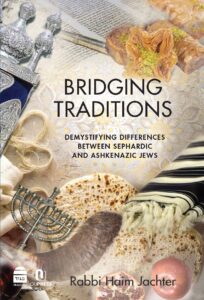Excerpted from Rabbi Haim Jachter’s Bridging Traditions: Demystifying Differences Between Sephardic and Ashkenazic Jews, co-published by OU Press and Maggid Books
 Clapping on Shabbat
Clapping on Shabbat
At a recent Bar Mitzva celebration at a West Coast Sephardic congregation, a well-meaning and beloved visiting Ashkenazic rabbi began to lead the community in song, dance, and clapping. This caused an awkward moment, as Sephardic Jews refrain from clapping their hands to song on Shabbat and Yom Tov.
The Mishna’s Prohibition
The mishna in Betza (36b) includes clapping and dancing on Shabbat and Yom Tov on a fairly long list of gezerot, Rabbinic decrees forbidding certain actions to prevent the violation of a Torah violation on these holy days. The gemara explains that Ĥazal feared that if we were to clap hands and dance to song on Shabbat, we would come to play and eventually fix or tune a musical instrument, a violation of the melacha of makeh bepatish.
Many Rishonim codify this ruling, including the Rambam (Hilchot Shabbat 23:5) and the Rif, Rabbenu Ĥananel, Rosh, and Meiri (on Betza 36b). Tosafot (Betza 30a s.v. Tenan), however, maintain that this gezera no longer applies, as the people in their time were no longer proficient in tuning musical instruments.
Tosafot’s approach is surprising. First, we remain, certainly in our times, capable of fixing and tuning musical instruments. Second, it is axiomatic that Rabbinic decrees remain in effect even if the reason for their enactment no
longer applies (“davar shebeminyan tzarich minyan aĥer l’hatiro”; Betza 5a).
Rav Yosef Karo, the primary Sephardic halachic authority, follows in the path of the majority of Rishonim in ruling that this decree remains in full effect in our times (Shulĥan Aruch, Oraĥ Ĥayim 339:3), whereas the Rama, the major Ashkenazic codifier, presents Tosafot’s approach as normative, noting that the common practice of Ashkenazic communities is to follow the lenient approach of Tosafot. It is important to note that the Mishna Berura (339:10) is not enthusiastic about this Ashkenazic practice and prefers adopting a strict approach to this matter.
Rav Ovadia Yosef vs. Aruch HaShulĥan
Not surprisingly, Rav Ovadia Yosef (Teshuvot Yabia Omer 3: Oraĥ Ĥayim 22; Teshuvot Yeĥaveh Da’at 2:57) vigorously endorses the ruling of the Shulĥan Aruch. Moreover, he even goes as far as to convince Ashkenazic Jews to refrain from clapping and dancing to song on Shabbat and Yom Tov.
Nonetheless, as noted by the Aruch HaShulĥan (Oraĥ Ĥayim 339:9), the Ashkenazic custom to be lenient has persisted. This is likely due to the fact that it is a bit counterintuitive to forbid clapping on Shabbat and Yom Tov lest one come to fix a musical instrument. Although the Aruch HaShulĥan rejects the justification offered by Tosafot and the Rama for this practice, he offers an interesting original defense, arguing that the gezera applies only to clapping and dancing to music that is being played. Clapping and dancing when music is not being played is not included in the gezera and is thus permitted on Shabbat and Yom Tov.
Although the Aruch HaShulĥan’s logic is compelling, Rav Ovadia notes that it lacks a solid basis in the gemara. Rav Ovadia is generally quite fond of the Aruch HaShulĥan’s approach to Halacha, and he quotes him frequently, but regarding this matter, Rav Ovadia believes that the ruling of the Aruch HaShulĥan’s view is not supported by proper evidence.
The great early twentieth-century Ĥassidic master, the Munkatcher Rebbe, attempted to defend the Ĥassidic practice to clap and dance to song on Shabbat and Yom Tov in his classic work Teshuvot Minĥat Elazar (1:29). He argues that the gezera never applied to a situation of mitzva, such as when Ĥassidim engage in singing in holy ecstasy.
Rav Ovadia handily dismisses this contention, however, noting that another great Ĥassidic Rebbe and Halachist – Rav Shneur Zalman of Liadi, the first Lubavitcher Rebbe – forbids clapping and dancing on Shabbat and Yom Tov even at a mitzva occasion, such as a rejoicing with a new bride and groom (Shulĥan Aruch HaRav 339:2).
Conclusion
Rav Ovadia concludes that one should gently urge any Jew who claps and dances to music on Shabbat and Yom Tov to refrain from doing so. However, Rav Yitzĥak Yosef (Yalkut Yosef, Oraĥ Ĥayim 339:5) limits this reproach to a Sephardic Jew who claps or dances to music on Shabbat and Yom Tov.
Even Rav Ovadia relents somewhat, permitting simply walking around in a circle while singing holy songs on Shabbat and Yom Tov, since this hardly qualifies as dancing (end of Teshuvot Yeĥaveh Da’at 2:57). Alumni of Yeshivat Har Etzion are fondly familiar with this approach, as our beloved Rav Aharon Lichtenstein similarly permitted only a shuffle around the hallway after the Friday night tefilla at the Yeshiva in joyously welcoming the holy day. Rav Shmuel Khoshkerman, however, is reluctant to permit even this sort of shuffle, since it may lead to confusion; if shuffling is permitted, people will think that full-fledged dancing is permissible as well.

